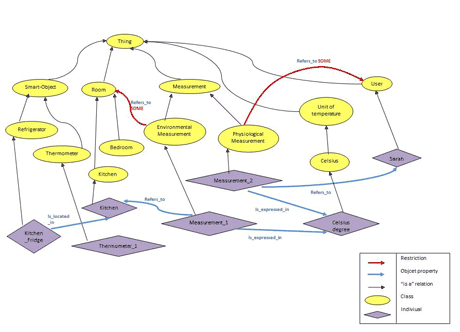by Daniele Spoladore, Gianfranco Modoni and Marco Sacco
An ontology based approach that aims at enhancing interoperability between home devices and services is being developed by the Italian “Design For All” research project.
Contemporary design is characterized by a major paradigm shift: from traditional design focused on the “average man” to Universal Design, which takes into account a wide variety of possible human needs [1]. This paradigm is also applied to the field of Ambient Assisted Living (AAL) in the design of smart homes, living environments capable of anticipating and responding to the needs of their inhabitants through tailored services provided by diverse devices (e.g. sensors and actuators). However, these smart objects are managed by different software, based on their specific data format. Thus, the home of the future is currently characterized by a wide variety of data, which hinders efficient interactions between the devices involved. In order to address this issue, the Design For All research project, co-funded by the Italian Ministry for Education, University and Research within the cluster of initiatives for Technologies for Ambient Assisted Living, is developing semantic interoperability so that different systems can share and exploit the same information.
The main goal of the project is to develop a software architecture that supports the design phase for future smart homes suitable for any kind of user, enabling distributed devices to adapt to and react with the context. A platform denoted the Virtual Home Framework (VHF) [2] integrates knowledge about the domestic environment, the smart objects and the users. Semantic Web technologies have been adopted to formally describe this information (including the many linking elements) in an ontology, which is a “formal specification of a shared conceptualization” based on first-order logic languages (RDF and OWL). The ontology approach provides a holistic view of the smart home as a whole, considering the physical dimensions, the users involved, and their evolution over the time. It also allows the use of reasoning tools, able to derive new knowledge about the concepts and their relationships, thanks to inferencing rules specified in the Semantic Web Rule Language (SWRL).
The semantic model developed, called the Virtual Home Data Model (VHDM), provides a consistent representation of several knowledge domains; it is composed of several modules including: a) the Physiology model, to keep track of users’ medical conditions over time; b) the Smart Object Model, which provides a description of the relationships between appliances and related functionalities; c) the Domestic Environment, which includes information on thermo-hygrometric conditions and air and light quality.
A valid starting point for the design of the VHDM has been a study of the various reference models available in the literature covering the relevant knowledge domains. For example, the Physiology model is based on the International Classification of Functioning, Disability and Health (ICF) (Figure 1); the Smart Object model refers to the existing Units Ontology, which represents units of measurement and related concepts, in order to support measurements in several fields (e.g. physiological data on the user, environmental data and data related to the smart objects) (Figure 2).

Figure 1: A fragment of the taxonomy derived from ICF.

Figure 2: An excerpt of the Smart Object model.
A key topic was the selection of a valid database that could manage and reason over large amounts of semantic data. A survey of the state of the art of existing semantic repositories was carried out stipulating reasoning capability as the main criteria of evaluation. On the basis of this qualitative analysis [3], Stardog was finally adopted as the RDF-store and SPARQL end point for the validation of the framework, since, compared to other solutions, this allows a higher level of expressivity to represent the inferencing rules. The semantic repository has been installed on a cloud-based platform (Microsoft Azure), which guarantees an efficient management of the overall framework’s horizontal scalability.
Link:
http://www.d4all.eu/en/
References:
[1] R. L. Mace, G. J. Hardie, J. P. Place: “Accessible Environments: Toward Universal Design”, 1991.
[2] M. Sacco, E.G. Caldarola, G. Modoni, W. Terkaj: “Supporting the Design of AAL through a SW Integration Framework: The D4All Project”, Universal Access in HCI, Springer, 2014.
[3] G. Modoni, M. Sacco, W. Terkaj: “A survey of RDF store solutions”, in Proc. of ICE, 2014.
Please contact:
Daniele Spoladore, Gianfranco Modoni
ITIA-CNR, Italy
E-mail: {daniele.spoladore, gianfranco.modoni}@itia.cnr.it











